Indoor gardening enthusiasts understand that optimal plant growth goes beyond regular watering; it necessitates understanding soil moisture retention, a pivotal factor in plant health. Soil moisture retention, as the term implies, is the soil’s ability to absorb, hold, and gradually supply moisture to plant roots, enabling the plant to absorb essential nutrients. A study featured in the Journal of Environmental Horticulture establishes a positive correlation between optimal soil moisture retention and an improvement in plant growth and yield.
To achieve optimal soil moisture retention, we must consider several elements such as the composition of the soil, the specific water requirements of various plant species, and the environmental conditions under which the plants are cultivated. Each of these factors interacts in different ways to influence the soil’s capacity to hold moisture, and finding the right balance can be the difference between a thriving indoor garden and a struggling one.
This comprehensive guide serves to illuminate these key factors and provide actionable strategies to improve soil moisture retention in indoor plants. Equipped with this knowledge, indoor gardeners will be able to cultivate an environment conducive to the well-being of their indoor flora, enhancing not just the plants’ health, but also the aesthetic appeal of their indoor spaces. Embark on this journey to learn about the science behind soil moisture retention and how it could transform your indoor gardening experience.
Key Factors Affecting Soil Moisture Retention in Indoor Plants
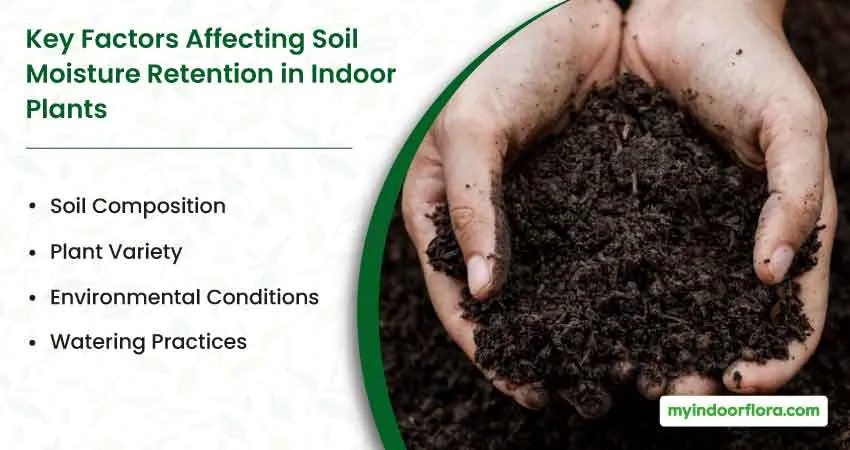
Before we dive into the techniques, let’s first discuss the main factors influencing soil moisture retention in indoor plants. By understanding these factors, you can make informed decisions when implementing retention techniques.
Soil Composition
The composition of your soil plays a crucial role in its ability to retain moisture. Soil can be made up of various organic and inorganic materials, with different compositions affecting moisture retention differently. For example, soils with higher amounts of organic matter tend to retain water more effectively.
Plant Variety
Different plant species have different water requirements, which can influence soil moisture retention. Some plants require more water, while others can survive with less. Choosing the right plant for your indoor environment is essential in managing moisture levels effectively.
Environmental Conditions
Temperature, humidity, airflow, and light exposure all affect soil moisture retention. For example, higher temperatures and low humidity levels can lead to faster evaporation of water from the soil, while proper airflow and light exposure can help maintain appropriate moisture levels.
Watering Practices
The way you water your plants and the frequency at which you do so can greatly impact soil moisture retention. Over-watering or under-watering can lead to various problems, including root rot, dehydration, and nutrient deficiencies. It’s essential to understand the moisture needs of your plants and adopt proper watering techniques.
How Can Soil Composition Be Optimized for Moisture Retention in Indoor Plants?
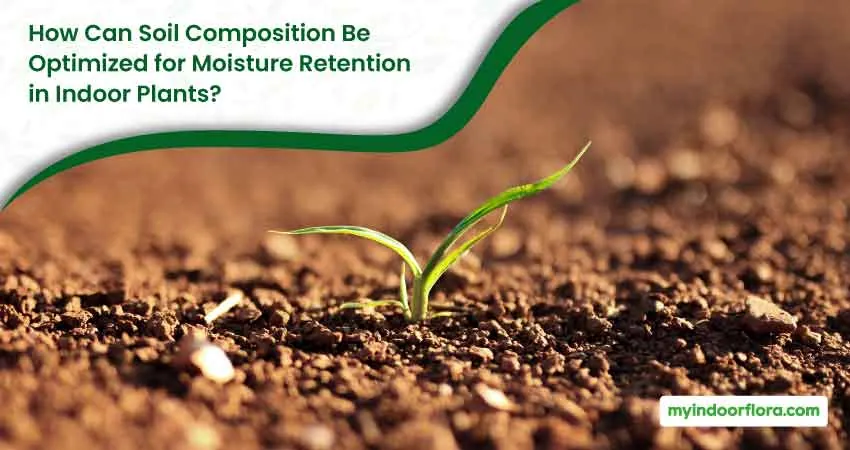
Soil composition is a key factor in moisture retention. In this section, we’ll explore ways to optimize soil composition for indoor plants to ensure that they receive the right amount of moisture.
Choosing the Right Soil Mix
An ideal soil mix for indoor plants should provide adequate moisture retention while allowing for proper drainage and aeration. There are several organic and inorganic materials that can be used to create a well-balanced soil mix.
Organic Materials
Organic materials like peat moss, coir, and compost can be used to improve the moisture retention capacity of your soil. These materials are rich in nutrients and can also help promote healthy root growth.
| Material | Benefits | Drawbacks |
|---|---|---|
| Peat Moss | Excellent moisture retention, lightweight, improves soil structure | Slow to absorb water, can become compacted, environmental concerns |
| Coir | Good moisture retention, renewable resource, improves soil structure | May contain salts, can decompose over time |
| Compost | Adds nutrients, improves soil structure, supports beneficial microorganisms | May contain pests or diseases, can be heavy |
Inorganic Materials
Inorganic materials like perlite, vermiculite, and sand can be added to your soil mix to enhance drainage, aeration, and moisture retention. These materials don’t break down over time, making them a long-lasting addition to your soil.
| Material | Benefits | Drawbacks |
|---|---|---|
| Perlite | Improves aeration and drainage, lightweight, sterile | Can float to the surface, dusty |
| Vermiculite | Excellent moisture retention, improves soil structure, provides some nutrients | Can compact over time, may contain asbestos if not properly sourced |
| Sand | Improves drainage, adds weight to the mix | Can compact and limit aeration |
Soil Amendments for Enhanced Moisture Retention
In addition to selecting the right soil mix, you can also add soil amendments to enhance moisture retention. These amendments can be added to your existing soil mix to help improve its water-holding capacity.
Coir
Coir, derived from coconut husks, is an excellent organic amendment for improving moisture retention in soil. It has a sponge-like structure that can hold up to 10 times its weight in water, making it ideal for retaining moisture. Additionally, coir is a renewable resource and has a neutral pH, making it an environmentally friendly choice.
Peat Moss
Peat moss is another organic amendment that is highly effective in retaining moisture. It can hold up to 20 times its weight in water, which is particularly beneficial for plants with high water requirements. However, peat moss can become compacted over time, which may limit its effectiveness in retaining moisture. Additionally, there are environmental concerns related to the harvesting of peat moss, so it’s essential to source it responsibly.
Vermiculite
Vermiculite is an inorganic amendment that can significantly improve soil moisture retention. It has a unique structure that allows it to hold water and slowly release it to the plant roots as needed. Vermiculite also helps improve soil structure and aeration. However, it’s crucial to source vermiculite from reputable suppliers, as some vermiculite may contain asbestos.
Perlite
Perlite is another inorganic amendment that can help improve moisture retention in soil. It’s a lightweight material that improves aeration and drainage while retaining some water. However, perlite may float to the surface of the soil when watered, which can be a drawback for some gardeners.
How Do Plant Varieties Influence Soil Moisture Retention?
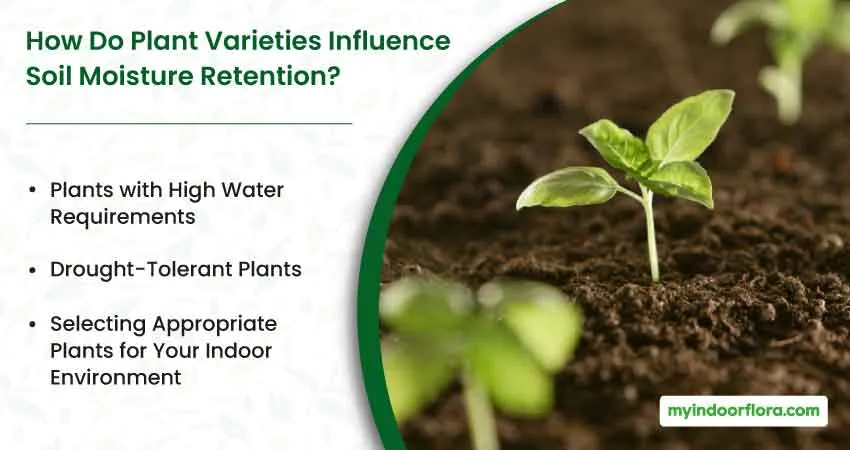
Different plant species have different moisture requirements, which can affect how well the soil retains moisture. In this section, we will discuss the relationship between plant varieties and soil moisture retention.
Plants with High Water Requirements
Plants with high water requirements, such as ferns and many tropical plants, need consistent moisture in their soil. These plants often benefit from soil mixes with higher moisture retention capabilities, such as those containing peat moss, coir, or vermiculite.
Drought-Tolerant Plants
Drought-tolerant plants, like succulents and cacti, require less water and can tolerate drier soil conditions. These plants often thrive in soil mixes with lower moisture retention capabilities, as they need proper drainage to prevent root rot. Soil amendments like perlite or sand can help ensure adequate drainage for drought-tolerant plants.
Selecting Appropriate Plants for Your Indoor Environment
To ensure proper moisture retention for your indoor plants, it’s essential to select the right plant varieties for your specific environment. Consider factors like the amount of natural light, temperature, and humidity in your space, as well as your ability to provide consistent care and watering.
How Do Environmental Factors Affect Soil Moisture Retention in Indoor Plants?
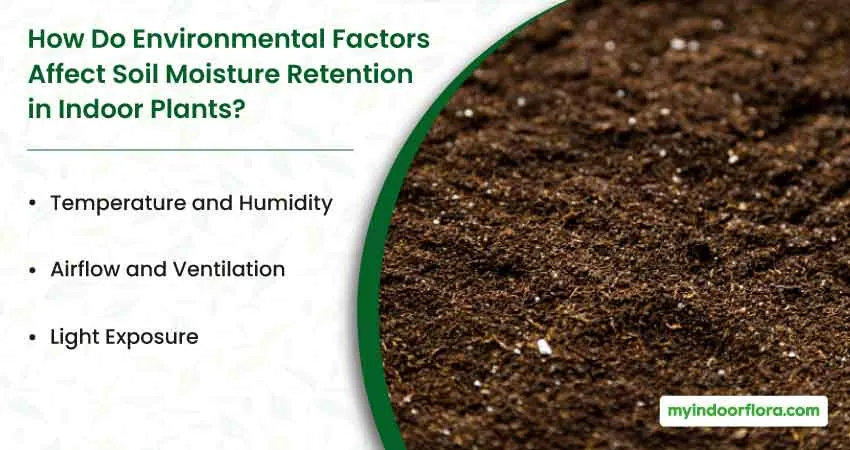
Environmental conditions play a significant role in soil moisture retention. In this section, we’ll explore the various environmental factors that can impact moisture retention and how to address them.
Temperature and Humidity
Higher temperatures and lower humidity levels can cause water to evaporate more quickly from the soil, leading to faster drying. To counteract these effects, you can use a humidifier to increase humidity levels or place a tray of water near your plants to help maintain moisture in the soil.
Airflow and Ventilation
Proper airflow and ventilation can help regulate soil moisture retention by promoting evaporation and preventing the growth of mold and mildew. Ensure that your indoor plants have access to adequate air circulation by placing them near open windows, vents, or using oscillating fans to create airflow.
Light Exposure
Light exposure can affect soil moisture retention by influencing the rate of evaporation and the plant’s water uptake. Plants in bright, direct light will generally require more water than those in low-light conditions, as they will use more water for photosynthesis and transpiration. Make sure to place your plants in appropriate light conditions based on their specific needs and adjust your watering practices accordingly.
Best Watering Practices for Soil Moisture Retention
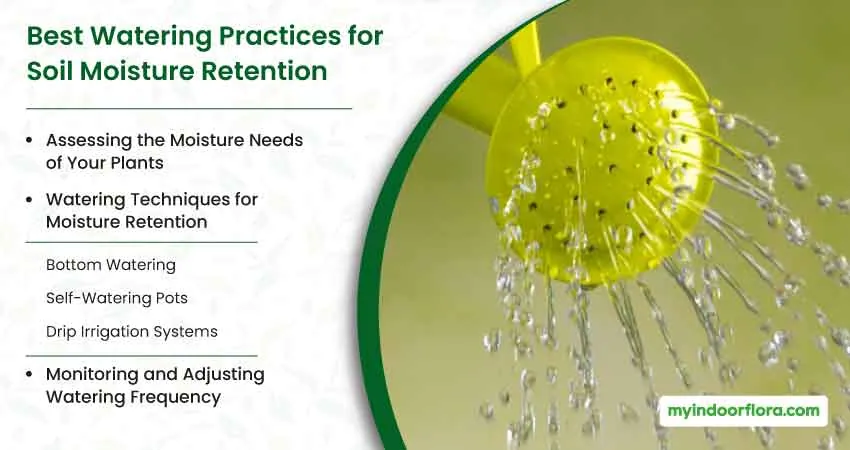
Proper watering practices are essential for maintaining soil moisture retention in indoor plants. In this section, we’ll discuss the best watering techniques to ensure your plants receive the right amount of moisture.
Assessing the Moisture Needs of Your Plants
It’s important to understand the specific moisture needs of your plants to provide them with the proper amount of water. Research the water requirements of your plant species and observe their growth habits to determine their needs. Signs of over-watering and under-watering can include yellowing leaves, wilting, and stunted growth.
Watering Techniques for Moisture Retention
There are several watering techniques that can help improve moisture retention in your indoor plants:
Bottom Watering
Bottom watering involves placing your plant pot in a tray or container filled with water, allowing the soil to absorb water through the drainage holes at the bottom. This method encourages the roots to grow downward in search of moisture, resulting in healthier root systems and better moisture retention.
Self-Watering Pots
Self-watering pots are designed with a built-in reservoir that holds water and slowly releases it to the soil. These pots can help maintain consistent moisture levels in the soil, reducing the risk of over-watering or under-watering.
Drip Irrigation Systems
Drip irrigation systems deliver water directly to the plant roots through a network of tubes and emitters. These systems can be set up to provide a consistent supply of water to your plants, helping to maintain optimal moisture levels in the soil.
Monitoring and Adjusting Watering Frequency
It’s crucial to monitor the moisture levels in your plant’s soil and adjust your watering frequency as needed. Use a moisture meter or the “finger test” (inserting your finger into the soil to gauge moisture levels) to determine when your plants need water. Be sure to account for changes in environmental conditions, such as temperature and humidity, which can affect soil moisture levels.
How Can Mulching Improve Soil Moisture Retention?
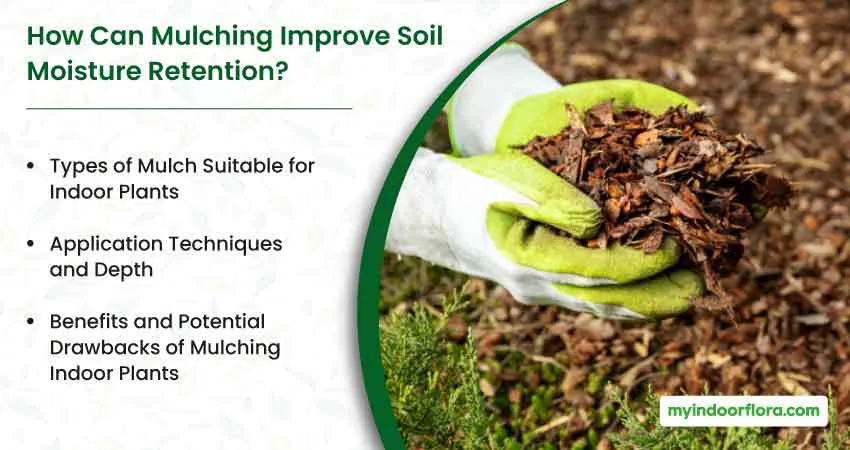
Mulching is a technique that can help improve soil moisture retention in indoor plants. In this section, we’ll discuss the types of mulch suitable for indoor plants, application techniques, and the benefits and potential drawbacks of mulching.
Types of Mulch Suitable for Indoor Plants
There are several types of mulch that can be used for indoor plants, including organic and inorganic options:
Organic Mulch
Organic mulch materials, such as shredded bark, wood chips, or cocoa bean hulls, can help retain moisture by reducing evaporation from the soil surface. As they decompose, they also add nutrients to the soil and improve soil structure.
Inorganic Mulch
Inorganic mulch materials, like gravel, pebbles, or glass beads, can help maintain soil moisture by reducing evaporation. These materials are long-lasting and don’t decompose, making them a low-maintenance option for indoor plants.
Application Techniques and Depth
To apply mulch to your indoor plants, spread a layer of your chosen material on the soil surface, being careful to leave some space around the plant’s stem to avoid rot. The ideal mulch depth for indoor plants is typically between 1 to 2 inches, depending on the size of the pot and the plant’s water requirements.
Benefits and Potential Drawbacks of Mulching Indoor Plants
Mulching can provide numerous benefits for indoor plants, such as:
- Improved moisture retention: Mulch reduces evaporation from the soil surface, helping to maintain consistent moisture levels.
- Temperature regulation: Mulch acts as an insulator, helping to keep the soil cool in hot conditions and warm in cooler conditions.
- Weed suppression: A layer of mulch can help prevent weed growth by blocking sunlight and making it difficult for weed seeds to germinate.
- Aesthetic appeal: Mulch can enhance the appearance of your indoor plants by providing a neat and finished look.
However, there are also some potential drawbacks to using mulch for indoor plants:
- Pests and diseases: Organic mulch materials can sometimes harbor pests or diseases, which could pose a risk to your indoor plants. Be sure to use clean, high-quality mulch to minimize this risk.
- Decomposition: Organic mulch materials will decompose over time, potentially altering the soil’s pH or nutrient levels. Monitor your plants closely and replace the mulch as needed.
Conclusion
Soil moisture retention is critical for the health and growth of indoor plants. By understanding the factors affecting moisture retention and implementing various techniques, such as optimizing soil composition, selecting the right plant varieties, managing environmental conditions, and adopting proper watering practices, you can create the ideal environment for your indoor plants to thrive. Additionally, incorporating mulching into your plant care routine can further improve moisture retention and contribute to the overall well-being of your indoor garden.
